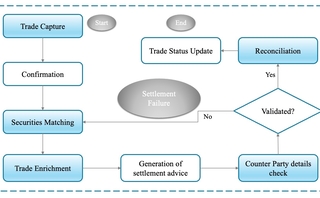Optical computer beats quantum tech in tricky settlement task
Microsoft’s analog technology twice as accurate compared to IBM’s quantum kit in Barclays experiment

Barclays has entered a joint development agreement with Microsoft to explore an application for an optical computer that has already outperformed a quantum computer by two orders of magnitude.
In April, Microsoft released a paper detailing how it used its optical computer called Aim to solve optimization problems including one focused on transaction settlement that had been tackled in a 2019 Barclays-IBM quantum computing collaboration.
Hitesh Ballani, partner researcher at Microsoft Research, says Aim solved the toy version of the transaction settlement problem with “double the accuracy” reported in Barclays’ paper with IBM.
The Microsoft researchers observed success rates of 99% and 100% for both the Aim hardware and its simulated version. IBM’s quantum hardware and simulated quantum hardware for the same problem had a success rate of 45% and 42%. The simulated versions of both the IBM and Microsoft experiments ran hybrid algorithms on classical computers.
Banks are testing embryonic quantum computers, which in theory are perfect for complex multivariate analysis.
Lee Braine, a managing director and distinguished engineer in Barclays’ chief technology office, says quantum computers, however, read only one output for each computation, meaning the statistical process must be run many times to derive the most frequent answer to an optimization problem.
Optical computing by contrast splits up the computation – as light that passes through a prism splits into a spectrum. “Imagine if that spread of colors is equivalent to all of the elements in a vector,” Braine says. “You can then process them in parallel and read the result at the end.”
Quantum computers are prone to errors if the hardware gets too warm, or as a result of stray microwaves and photons, or manufacturing defects. The computers must also run in a laboratory at sub-zero temperatures.
Optical computing uses far cheaper components that can be put together on a tabletop.
Microsoft’s Ballani says: “One of the reasons the Project Aim computer is faster, lower power and has a better scaling path is because it uses classical optics, with an algorithm designed to take advantage of the strengths of the underlying hardware, at room temperature. The latter turns out to be a big practical advantage on a day-to-day basis. We go to the lab, we run the experiment – there is no cryostat involved.” Cryostats are used in quantum computing to keep machines cool.
Analog optical computing has been around for decades and uses light instead of electrons, performing complex mathematical operations at extremely high speed in parallel.
“An optical computer doesn’t need to rely on the almost magical world of quantum superpositions and entanglement, which can be like having a multiverse for exploring the many possible paths of a computation,” says Braine.
Project Aim also avoids transferring a problem back and forth between storage and compute locations, giving it an advantage over digital computers. That means it can deliver about 100 times the efficiency for the same power as state-of-the-art digital solvers for problems with 10,000 variables.
Digital computers experience a processing impediment as an instruction fetch and a data operation cannot occur at the same time on a shared bus, thus limiting performance.
Ballani says: “One of the biggest bottlenecks for digital computers is the bandwidth between compute and memory. One of the most brilliant things about our optical computer is that we combine the two. The projector is operating as a memory and encoding the problem, light is flowing through the projector, and computations happen as light passes through the projector.”
In a transaction settlement problem, parties must receive assets they are entitled to in a timely process. If one party fails to meet their obligations, the system may suffer a chain reaction of unsettled transactions. Settling an optimal batch of delivery-versus-payment (DVP) securities transactions is a problem common to financial market infrastructures such as Clearstream and the Depository Trust & Clearing Corporation, which in the real world would handle tens of thousands of transactions in a rapid batch process.
Barclays’ previous experiments on an IBM quantum computer looked at less than 10 transactions, and only three parties that would handle those transactions. The Microsoft experiment will scale up to around 50 transactions and is expected to have “much higher precision in terms of the amounts and values processed, and more complexity in terms of the connectivity in the network graph of those DVP transactions”, says Braine.
“We will be ramping up the complexity in the transaction datasets, so that it more accurately reflects reality. Things like long chains of back-to-back transactions that are only implicitly linked, and also cyclic dependencies of transactions. The algorithm then needs to work harder to find the liquidity to optimize settlement efficiency,” Braine explains.
The challenge for the industry is: do they also start looking at this?
Lee Braine, Barclays
Results are expected in late summer with a research note towards the end of the year.
Next year, Braine says Barclays may look to apply the “radically new type of hardware” to problems such as machine learning or fraud detection. Further on, the hardware could be applied to risk calculation problems like XVAs, which are “another one of the big classes of opportunities”, he says.
“Some of these calculations are run on very large parallel compute clusters currently, with many CPUs doing the calculations in parallel.”
Microsoft will offer Aim in a simulator-as-a-service, initially only to academic collaborators at Princeton University and the University of Cambridge, in addition to Barclays.
Optical computing has the potential to scale faster than quantum computers but likely won’t have the same ultimate power. Braine doesn’t think optical computing could break internet decryption in the same way that quantum computing could, for example.
But in the meantime, he says, optical computers have the promise to be a lot cheaper and potentially able to solve problems faster than current versions of quantum computers. “The challenge for the industry is: do they also start looking at this?”
Only users who have a paid subscription or are part of a corporate subscription are able to print or copy content.
To access these options, along with all other subscription benefits, please contact info@waterstechnology.com or view our subscription options here: http://subscriptions.waterstechnology.com/subscribe
You are currently unable to print this content. Please contact info@waterstechnology.com to find out more.
You are currently unable to copy this content. Please contact info@waterstechnology.com to find out more.
Copyright Infopro Digital Limited. All rights reserved.
You may share this content using our article tools. Printing this content is for the sole use of the Authorised User (named subscriber), as outlined in our terms and conditions - https://www.infopro-insight.com/terms-conditions/insight-subscriptions/
If you would like to purchase additional rights please email info@waterstechnology.com
Copyright Infopro Digital Limited. All rights reserved.
You may share this content using our article tools. Copying this content is for the sole use of the Authorised User (named subscriber), as outlined in our terms and conditions - https://www.infopro-insight.com/terms-conditions/insight-subscriptions/
If you would like to purchase additional rights please email info@waterstechnology.com
More on Emerging Technologies
Quants look to language models to predict market impact
Oxford-Man Institute says LLM-type engine that ‘reads’ order-book messages could help improve execution
The IMD Wrap: Talkin’ ’bout my generation
As a Gen-Xer, Max tells GenAI to get off his lawn—after it's mowed it, watered it and trimmed the shrubs so he can sit back and enjoy it.
This Week: Delta Capita/SSimple, BNY Mellon, DTCC, Broadridge, and more
A summary of the latest financial technology news.
Waters Wavelength Podcast: The issue with corporate actions
Yogita Mehta from SIX joins to discuss the biggest challenges firms face when dealing with corporate actions.
JP Morgan pulls plug on deep learning model for FX algos
The bank has turned to less complex models that are easier to explain to clients.
LSEG-Microsoft products on track for 2024 release
The exchange’s to-do list includes embedding its data, analytics, and workflows in the Microsoft Teams and productivity suite.
Data catalog competition heats up as spending cools
Data catalogs represent a big step toward a shopping experience in the style of Amazon.com or iTunes for market data management and procurement. Here, we take a look at the key players in this space, old and new.
Harnessing generative AI to address security settlement challenges
A new paper from IBM researchers explores settlement challenges and looks at how generative AI can, among other things, identify the underlying cause of an issue and rectify the errors.








